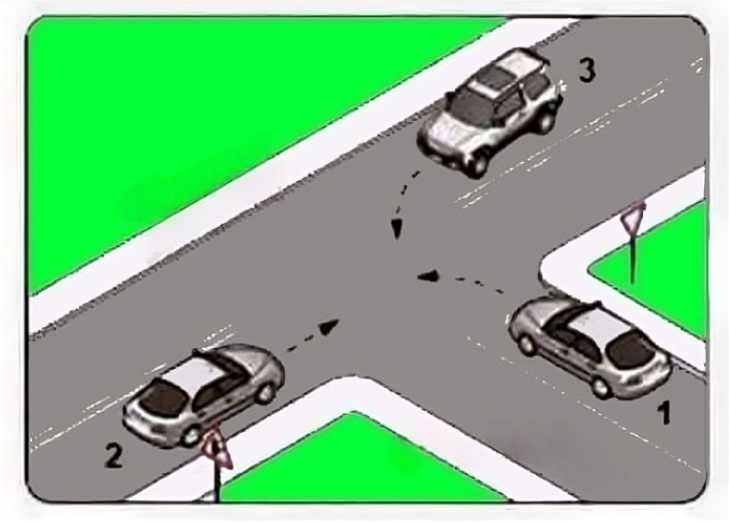Traffic scenarios are more than just everyday challenges for drivers—they’re practical puzzles that test your ability to apply road rules and logic in real-time. One common dilemma arises at intersections: which car should move first? Imagine three vehicles, numbered 1, 2, and 3, waiting at an intersection. Determining who has the right of way might seem simple, but the answer depends on observing traffic signs and understanding basic priority rules.
Let’s dive into this puzzle and solve it step by step, sharpening our traffic sense along the way.

The Importance of Traffic Puzzles
Traffic puzzles aren’t just entertaining—they’re educational tools that improve your decision-making on the road. By solving such scenarios, you enhance your understanding of traffic laws and become a more attentive driver. They simulate real-world situations where quick, logical decisions can prevent accidents and keep everyone safe.
This puzzle isn’t about random guessing; it’s about applying road rules effectively. Ready to crack it?
Common Errors People Make in Traffic Scenarios
Before solving the puzzle, it’s worth noting the frequent mistakes drivers make in similar situations. Understanding these errors will help you avoid them both in puzzles and real-life driving.
1. Overlooking Traffic Signs
Ignoring yield or stop signs is one of the most common errors. These signs dictate priority at intersections and are crucial to understanding the flow of traffic.
2. Misinterpreting the Right-Hand Rule
Some drivers assume the right-hand rule always applies. While this rule often resolves conflicts at intersections, it’s secondary to traffic signs and road markings.
3. Assuming Position Dictates Priority
Just because a car is closer to the intersection doesn’t mean it has the right of way. Priority is determined by the rules, not proximity.
4. Rushing Through Decisions
In both puzzles and real-life driving, hasty decisions can lead to errors. Taking a moment to analyze the situation thoroughly is always a better approach.
Step-by-Step Solution to the Puzzle
Let’s analyze the puzzle logically. Imagine three cars—Car 1, Car 2, and Car 3—approaching an intersection. The goal is to determine the correct order of movement.
Step 1: Observe Traffic Signs
The first and most critical step is to look for traffic signs. In this scenario:
- Car 2 is on a priority road. This is indicated by a priority sign visible to Cars 1 and 3.
- Cars 1 and 3 are at yield signs, meaning they must allow traffic on the priority road to pass first.
Conclusion: Car 2 moves first because it has priority.
Step 2: Apply the Right-Hand Rule
Once Car 2 has moved through the intersection, Cars 1 and 3 are left to decide who goes next. Since both are at yield signs, the right-hand rule comes into play. According to this rule, when two cars face the same conditions, the vehicle on the right has the right of way.
- Car 3 is to the right of Car 1.
Conclusion: Car 3 moves second.
Step 3: The Last Vehicle
After Cars 2 and 3 have moved, only Car 1 remains. With no other vehicles to yield to, Car 1 can now proceed safely.
Final Order: Car 2 → Car 3 → Car 1.
Breaking Down the Logic
The sequence is based on a combination of traffic signs and basic rules. Here’s why this order makes sense:
- Car 2 Moves First: As it’s on a priority road, Car 2 doesn’t need to yield.
- Car 3 Moves Next: With Car 2 gone, Car 3 takes priority over Car 1 due to the right-hand rule.
- Car 1 Moves Last: Having yielded to both Cars 2 and 3, Car 1 can now proceed.
This logical flow ensures that all vehicles navigate the intersection safely and efficiently.
Why Traffic Details Matter

Small details like traffic signs and positioning play a huge role in puzzles like this—and in real-world driving. Missing a single clue can lead to incorrect answers or, worse, dangerous situations on the road. Here’s why attention to detail is essential:
- Safety First: Understanding traffic rules helps prevent accidents.
- Improved Awareness: Practicing scenarios sharpens your ability to spot critical signs and cues.
- Confidence in Decision-Making: Knowing the rules ensures you act decisively and correctly, even under pressure.
Tips for Solving Similar Puzzles
Want to ace more traffic puzzles? Here are a few tips:
- Study the Signs: Always prioritize understanding the meaning of traffic signs—they’re the foundation of most solutions.
- Think Logically: Break the scenario into smaller parts and solve step by step.
- Practice Patience: Avoid rushing to conclusions; carefully analyze all the clues before deciding.
- Learn the Rules: Familiarize yourself with priority rules like the right-hand rule and exceptions to it.
Challenge Your Friends
Now that you know the solution, it’s time to challenge others! Share this puzzle with your friends and family to see if they can figure out the correct order. Discussing different approaches is a fun way to learn and improve together.
Conclusion: Sharpen Your Traffic Sense
Traffic puzzles like this one aren’t just brain-teasers—they’re valuable exercises that enhance your understanding of road rules. By solving them, you not only train your mind but also become a more responsible and attentive driver.
Remember, the key to mastering such puzzles is paying attention to details, applying logical reasoning, and staying calm under pressure. So the next time you encounter a tricky intersection—whether on paper or on the road—you’ll know exactly what to do.
Happy puzzling, and safe driving!



